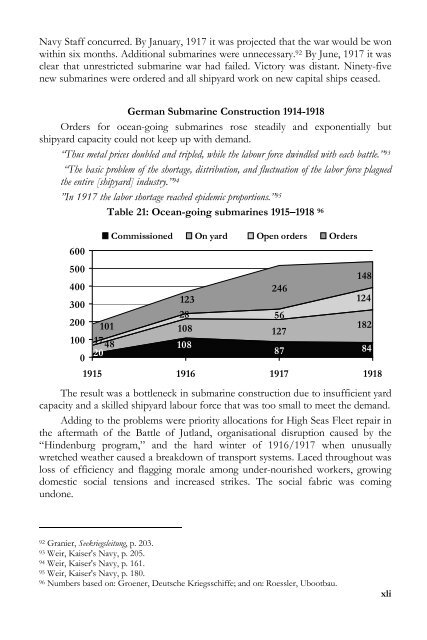German Submarine Warfare 1914-1918 in the Eyes - British Naval ...
German Submarine Warfare 1914-1918 in the Eyes - British Naval ...
German Submarine Warfare 1914-1918 in the Eyes - British Naval ...
Create successful ePaper yourself
Turn your PDF publications into a flip-book with our unique Google optimized e-Paper software.
Navy Staff concurred. By January, 1917 it was projected that <strong>the</strong> war would be won<br />
with<strong>in</strong> six months. Additional submar<strong>in</strong>es were unnecessary. 92 By June, 1917 it was<br />
clear that unrestricted submar<strong>in</strong>e war had failed. Victory was distant. N<strong>in</strong>ety-five<br />
new submar<strong>in</strong>es were ordered and all shipyard work on new capital ships ceased.<br />
<strong>German</strong> <strong>Submar<strong>in</strong>e</strong> Construction <strong>1914</strong>-<strong>1918</strong><br />
Orders for ocean-go<strong>in</strong>g submar<strong>in</strong>es rose steadily and exponentially but<br />
shipyard capacity could not keep up with demand.<br />
“Thus metal prices doubled and tripled, while <strong>the</strong> labour force dw<strong>in</strong>dled with each battle.” 93<br />
“The basic problem of <strong>the</strong> shortage, distribution, and fluctuation of <strong>the</strong> labor force plagued<br />
<strong>the</strong> entire [shipyard] <strong>in</strong>dustry.” 94<br />
”In 1917 <strong>the</strong> labor shortage reached epidemic proportions.” 95<br />
600<br />
500<br />
400<br />
300<br />
200<br />
100<br />
0<br />
101<br />
1748<br />
20<br />
Table 21: Ocean-go<strong>in</strong>g submar<strong>in</strong>es 1915–<strong>1918</strong> 96<br />
Commissioned On yard Open orders Orders<br />
123<br />
28<br />
108<br />
108<br />
246<br />
1915 1916 1917 <strong>1918</strong><br />
The result was a bottleneck <strong>in</strong> submar<strong>in</strong>e construction due to <strong>in</strong>sufficient yard<br />
capacity and a skilled shipyard labour force that was too small to meet <strong>the</strong> demand.<br />
Add<strong>in</strong>g to <strong>the</strong> problems were priority allocations for High Seas Fleet repair <strong>in</strong><br />
<strong>the</strong> aftermath of <strong>the</strong> Battle of Jutland, organisational disruption caused by <strong>the</strong><br />
“H<strong>in</strong>denburg program,” and <strong>the</strong> hard w<strong>in</strong>ter of 1916/1917 when unusually<br />
wretched wea<strong>the</strong>r caused a breakdown of transport systems. Laced throughout was<br />
loss of efficiency and flagg<strong>in</strong>g morale among under-nourished workers, grow<strong>in</strong>g<br />
domestic social tensions and <strong>in</strong>creased strikes. The social fabric was com<strong>in</strong>g<br />
undone.<br />
92 Granier, Seekriegsleitung, p. 203.<br />
93 Weir, Kaiser's Navy, p. 205.<br />
94 Weir, Kaiser's Navy, p. 161.<br />
95 Weir, Kaiser's Navy, p. 180.<br />
96 Numbers based on: Groener, Deutsche Kriegsschiffe; and on: Roessler, Ubootbau.<br />
56<br />
127<br />
87<br />
148<br />
124<br />
182<br />
84<br />
xli




